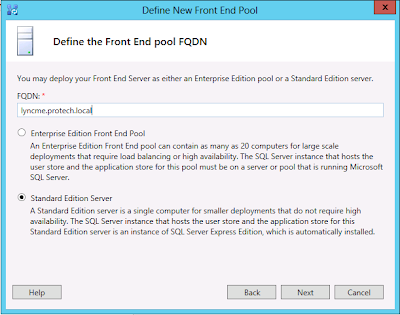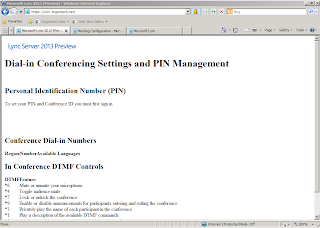Tuesday, July 24, 2018
Lync Server 2013 Preview Step by Step Guide Part 2
Lync Server 2013 Preview Step by Step Guide Part 2
In part one which can be found here, I mentioned all the prerequisites for Lync Server 2013 Preview including Windows Identity Foundation. In Part 2 we will go through creating DNS Records, publishing the Topology and getting the client working with IM and the meet/dialin URLS published.
Before I continue with creating my new Topology, I need to configure my DNS!
My DNS will look like this
A Records
meet/dialin.myprotech.net - 192.168.100.21
lyncme.myprotech.net - 192.168.100.21
lyncme.protech.local - 192.168.100.21
lyncdiscoverinternal.myprotech.net - 192.168.100.21
SRV Record
_sipinternaltls._tcp.myprotech.net -> lyncme.protech.local
After selecting New Topology enter your Primary SIP Domain. This will be the domain used for all your Lync clients. I try and always use their email domain.

On the next screen is where you can add additional SIP domains, but since this is a lab environment I will be sticking with 1 SIP domain.
Enter your Site Name details

Next is to specify your site details. City, State/Provice and Country/Region Code.

And then click finish to Open the New Front End Wizard.
For my Front-End Pool I will only be creating a Standard Edition Pool. And need to enter my FQDN of that server.

On the next screen you will have the options of selecting the features of your front-end pool. In this guide I will be configuring Conferencing, Enterprise Voice.
***NOTE*** A new feature to Lync Server 2013 Preview and the ability to enable Exchange Server intergration into the Archiving feature.

I am going to Collocate my Mediation Server on the Standard Edition Pool

The next screen is asking to associate an Edge pool. For now I won�t be adding an Edge to this Topology. But in another guide I will be adding an Edge to configure external user access, Federation and Voicemail to Office 365. So for now I will leave this screen unchecked and continue.
For a Standard Edition we do not specify a SQL Server store, it is installed automatically which you will see later on in this guide. So we simply click Next.

The next window is asking us to define a new file share. On a Standard Edition the share can reside on the Standard Edition Server. On an Enterprise Edition Pool the Share cannot be on any of the front end servers.
So I create a new folder and share it out with the name "share" and give full access to the Everyone Group, as the Lync install will configure the correct permissions afterwards.


Next we will override the External Web Services Base URL as this is something that will be required for meet/dialin/lync mobility from the external network.

Next screen will allow you to select your web apps server. if you don�t know what a web app server is or how to deploy one I will be writing an article on it, but for the time you can read the details from Microsoft here.
Specify your web app server and click Finish.



the next window will ask to select the Central Management Store, since this is a Standard Edition Deployment we will just click Next.

Confirm your Topology published successfully and click Finish


Click "Run" on Step 1 "Install Local Configuration Store"
The next window we will leave the default "Retrieve directly from the Central Management store" and click Next

Let the wizard install the Lync Server Components. And click Finish after confirming the install was successful.

Next step is Request, Install Certificate Wizard. Click "Run".

For simplicity sake I�m going to request my 3 certificates from my internal Certificate Authority. In real world you would purchase a 3rd party certificate for your web services external.

Enter in all your information, Company, City, Region etc... You will get to the SAN Names list which since I�m bundling all my certificates into 1 has my mobility (lyncdiscover), my dialin/meet urls etc...



Once you have requested and assigned all your certificates you will be taken back to the Certificate Wizard. Notice the "Location Field. The Default Certificates say Local, the OAuth Certificate says Global. the OAuth certificate when it was published to Lync was also published to the CMS... I�ll go into the OAuth in another post.

Start your Services



First look at the control panel looks very similar to Lync Server 2010 Control Panel. First I noticed the Persistent Chat menu on the left. But none configured..... yet!
I always check my topology to confirm started services and replication. Noticed right away we have a version column. I would assume at this point this will also show Lync Server 2010 for those servers.... an obvious assumption.

So let�s create a user and get them signed into Lync!
Adding a user just like in Lync 2010 is straight forward. But again with some added function. You know have the ability to sign additional policies to your users. These policies being Mobility and Persistent Chat.

So now I have my user, let�s fire up Lync Server 2013 Client that was installed with Office 2013 ProPlus. If you would like to download the ProPlus version of Office 2013 Preview that comes with the new Lync client, you can get started here.

And there we have it, logged into Lync 2013 Client on Lync Server 2013 Preview. And below is the dial in and meet url screen shots.


The process is much similar to Lync Server 2010 with some add-ons. Prerequisites of PowerShell 3.0 and .NET 4.5 for Server 2008 R2 SP1 installations. the Topology builder got a nice upgrade, being able to see both 2010 and 2013 topologys from the same window is excellent. OAuth for server-to-server authentication, which will be something I talk about in the upcoming weeks/months. The Control Panel also has some new features like, creating Mobility and Push policies, XMPP Federated Partner feature and Persistent Chat.
One addon I would like to mention is the Conferencing Meeting Configuration. Now you can configure your logo, header and footer of your meet.domain page from the control panel.

Thank you for reading, I hope this was informative on both the configuration and new features of Lync and Lync Server 2013 Preview. Next I will be diving into specifics of Lync 2013 Preview features.